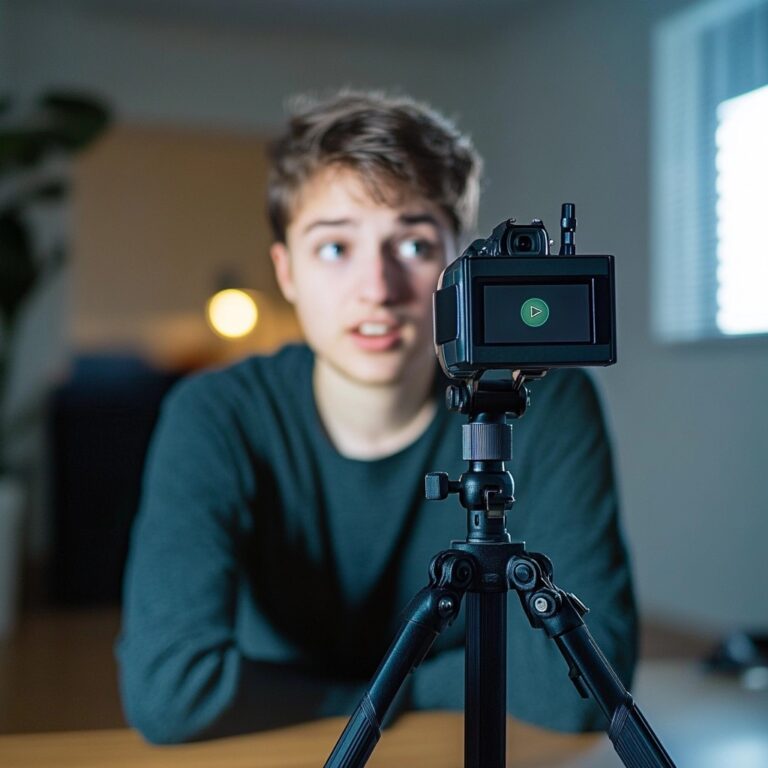The Ultimate Guide to Content Marketing

- 1. What is content marketing?
- 2.
- 3. The different types of content marketing
- 4. How to approach content marketing
- 5. Learn more from the masters of content marketing
- 6. What is content marketing?
- 7. The different types of content marketing
- 8. How to approach content marketing
- 9. Learn more from the masters of content marketing
Content marketing is on the rise and not slowing down any time soon. With 82% of content marketers actively using vlogs, podcasts and other creative content to reach audiences,1 this attention-grabbing approach to digital marketing and advertising is here to stay. Content marketing and digital marketing have eclipsed traditional marketing in the last couple of years.
But what is content marketing? What are the benefits of content marketing? And why should using it to its full potential live near the top of your to-do list? We’ll be answering these questions—and so many others—as we make our way through this ultimate guide.
What is content marketing?
On paper, content marketing is easy to define: It’s content (blogs, videos and more) used for marketing purposes. In general, content marketing casts aside traditional advertising in favor of more entertaining or informative assets.
In practice, however, content marketing is more of an all-encompassing philosophy. It represents a shift in the way brands interact with consumers. It’s a transition from the “old way” of marketing (selling products or services to the public) to the “new way” (entertaining and informinga specific target audience).
Content marketing is all about providing value to existing and future customers. By creating and sharing content that is fun, funny or informative, brands can naturally build trust with their target audience. Compared to the traditional media approach—which is disruptive and often in-your-face—content marketing is the approachable, more organic path to building loyalty and boosting revenue.
The different types of content marketing
Although its goal of “increasing sales without feeling sales-y” remains the same, content marketing takes dozens of different forms. Broadly speaking, all types of content marketing fall under one of five categories
Visual content marketing
Our forefathers drew on cave walls and we’ve been basically scrolling visual content ever since. , it has played a role in marketing and advertising since the dawn of Madison Avenue.
But now, when billions of people have high-quality cameras and editing software in their back pockets,2 visual content and video marketing are more prevalent than ever. The three most typical forms of visual content marketing are:
- Video – Arguably the most important (and most viewed) form of content marketing, video content is king. In 2022, Americans watched 6.8 billion hours of online video.3 While pre-recorded videos are the bread and butter of streaming platforms and social media, live streaming on platforms like YouTube and Twitch is seeing a meteoric rise.4
- Images – From gorgeous landscape photos to intentionally rudimental memes, pictures really are worth a thousand words. While they may not be as visually stimulating as video, still images remain a smaller-budget solution for visual content marketing.
- Infographics – The infographic is the ideal marriage of visual and written content. Colorful charts and diagrams offer a more aesthetically-pleasing way to distill information than a lengthy whitepaper.
Audio content marketing
Podcasts currently dominate the audio sphere, with 57% of Americans over 12 identifying as listeners.5 But let’s not discount other audio mediums. Anything from an audiobook to an ASMR video content can be an auditory vessel for your brand’s message.
For a more extreme example, there’s the hip-hop EP We Beefin?6 Released by the fast food chain Wendy’s (seriously), the mixtape is a masterclass in creative audio content marketing—even if it won’t be winning a Grammy any time soon.
Written content marketing
In a world where attention feels like an ever-shrinking commodity, the written word often takes a backseat to more engaging content format. However, writing still holds a sizable sway in content marketing. For anything that requires authority or detailed context, written content remains number one.
There are several kinds of written content marketing, including:
- Blog posts
- Listicles
- Whitepapers
- Case studies
- eBooks
- Checklists
Written content marketing is fundamental to search engine optimization (SEO), the strategy that helps brands rank higher on search engine results pages. SEO and content marketing work together to increase visibility and drive engagement.
Social media content marketing
Much of the content on a social media platform is visual, audio and written. For that reason—as well as the enchantment that social media has over consumers—social media content marketing deserves its own category.
Thanks to the ever-evolving nature of platforms like TikTok, Instagram marketing, Facebook and YouTube, social media marketing can be either:
- Temporary content – Instagram stories and Snapchat messages are ephemeral media, lasting 24 hours at most.
- Static posts – Photos and videos posted to a page or timeline are more immortal. Static posts include everything from three-word tweets to 10-minute TikToks.
User-generated content marketing
Yet another category that defies categorization, user-generated content (UGC) can be any of the above. UGC is any engaging content that a member of your audience makes (typically without remuneration).
Most commonly, UGC is a social media post or story, but it can also show up as:
- A testimonial
- A video tutorial
- A product or brand review
- A blog post or comment
Encouraging UGC from your supporters is one of the easiest ways to cushion your marketing budget while leaning into organic content marketing.
Others include email marketing and other outbound marketing and advertising practices.
How to approach content marketing
No matter which type of content you feel suits your brand, the approach to building (or refining) your content marketing strategy stays largely the same. Here’s a quick blueprint for developing a content marketing strategy.
Step 1: Define your audience
Like any other marketing effort, your content marketing framework should start with a target audience deep-dive. Who are your existing customers? Maybe you already know who your target audience is. But do you know what kind of content they prefer?
Start by ensuring your buyer persona is up to date. Along with your ideal customer’s age and income bracket, you’ll list their likes and dislikes, hobbies, preferred media sources and lifestyle choices. Prepare for plenty of research (or a partnership with a digital marketing company).
When you have a picture of your perfect persona, you can create content that speaks directly to them—and deliver it to them wherever they are.
Step 2: Examine your current content
Chances are you’re already producing relevant content that you can use for content marketing. Whether its brand blogs, tweets or live streams, you’re on the right track.
If you’ve published content in the past, there’s also likely some valuable data waiting at your fingertips. Most platforms provide performance metrics to gauge past content performance.
Look back at all of your relevant content from the past year and note the number of:
- Views
- Likes
- Clicks
- Comments
- Shares
You now have a much clearer understanding of which valuable content lands well, and which doesn’t. From there, you can set goals for your upcoming content marketing campaign and measure success in a more meaningful way.
Step 3: Plan your upcoming content
The biggest mistake brands make when creating content is embarking without a content strategy. With a target audience and a set of KPIs at hand, you’re already a step ahead. But you’ll still want to plan out your content for the best results.
For written content creation, preparing typically means building topic clusters and relevant keyword research before writing. For videos, you’ll want to spend time writing scripts and scouting locations. Other types of content will require different arrangements.
Your plan should also include how and when you’ll disseminate your content. Which channels will you utilize? Will you add paid media to your strategy? How frequently do you want to post? Depending on your budget and goals, this part of the plan will vary.
Step 4: Produce and publish your new content
Finally, it’s time to write, record or re-share your content. Thanks to your thorough planning, this should be the simplest step of the process. Once you’re happy with the final product, you can start sharing it as per your plan.
It’s worth noting here that one piece of quality content can easily become several. Repurposing content is one of the best ways to ensure your marketing well never dries up. For example, one long-form blog post could also become:
- A series of social posts
- An infographic
- A video summary
- A section of a whitepaper
Repurposing your valuable content also allows you to cover multiple channels simultaneously—without spending a ton of extra time or money.
Step 5: Analyze and react
Your content marketing campaign doesn’t end when you press “Publish.” Using built-in analytics tools and third-party dashboards, you can track every aspect of every post to see what’s working and what isn’t.
Most importantly, when you notice a trend, pounce on it. Data is only as useful as the actions it prompts. If a video series isn’t bringing you the ROI you hoped for, don’t be afraid to pivot. If a one-off podcast generates significant buzz, be prepared to write an entire season. Successful content marketing is all about flexibility—but knowing when to be flexible comes from analysis.
Learn more from the masters of content marketing
In the end, content marketing is the marketing strategy du jour. But it’s far from a fad. Content marketing is here to stay, and if you want to see lasting growth, you need to see it through.
While this is an ultimate guide, there’s so much to know and learn about content marketing—far more than can fit in a blog post. For insights and info that go far beyond the surface, there’s our digital marketing agency.
Part SEO company, part content marketing agency, and all growth marketing firm, Power Digital exists to help brands reach their full potential. Whether you need a nudge in the right direction or a total overhaul, our team of experts can take your brand where you want it to go.
To chat more about our content marketing and other services, get in touch today. We’re ready to hit the ground running. Are you?
Sources:
- Ahrefs. 63 Content Marketing Statistics for 2023. https://ahrefs.com/blog/content-marketing-statistics
- Statista. Number of smartphone subscriptions worldwide from 2016 to 2021, with forecasts from 2022 to 2027. https://www.statista.com/statistics/330695/number-of-smartphone-users-worldwide/
- Statista. Cumulative monthly time spent watching video content in the United States from March 2019 to March 2022 (in billion hours), by device. https://www.statista.com/statistics/1327396/cumulative-time-spent-watching-online-video-us/
- Forbes. Going Live Online: The State Of Live Streaming And The Opportunities For Brands. https://www.forbes.com/sites/forbesagencycouncil/2021/02/04/going-live-online-the-state-of-live-streaming-and-the-opportunities-for-brands/
- Forbes. Podcasts Are A Powerful Storytelling And Advertising Tool. https://www.forbes.com/sites/jiawertz/2021/12/31/podcasts-are-a-powerful-storytelling-and-advertising-tool/
- Wendy’s. The Wendy’s ‘webeefin’ Mixtape Story. https://www.wendys.com/blog/wendys-mixtape-story
Content marketing is on the rise and not slowing down any time soon. With 82% of content marketers actively using vlogs, podcasts and other creative content to reach audiences,1 this attention-grabbing approach to digital marketing and advertising is here to stay. Content marketing and digital marketing have eclipsed traditional marketing in the last couple of years.
But what is content marketing? What are the benefits of content marketing? And why should using it to its full potential live near the top of your to-do list? We’ll be answering these questions—and so many others—as we make our way through this ultimate guide.
What is content marketing?
On paper, content marketing is easy to define: It’s content (blogs, videos and more) used for marketing purposes. In general, content marketing casts aside traditional advertising in favor of more entertaining or informative assets.
In practice, however, content marketing is more of an all-encompassing philosophy. It represents a shift in the way brands interact with consumers. It’s a transition from the “old way” of marketing (selling products or services to the public) to the “new way” (entertaining and informinga specific target audience).
Content marketing is all about providing value to existing and future customers. By creating and sharing content that is fun, funny or informative, brands can naturally build trust with their target audience. Compared to the traditional media approach—which is disruptive and often in-your-face—content marketing is the approachable, more organic path to building loyalty and boosting revenue.
The different types of content marketing
Although its goal of “increasing sales without feeling sales-y” remains the same, content marketing takes dozens of different forms. Broadly speaking, all types of content marketing fall under one of five categories.

Visual content marketing
Our forefathers drew on cave walls and we’ve been basically scrolling visual content ever since. , it has played a role in marketing and advertising since the dawn of Madison Avenue.
But now, when billions of people have high-quality cameras and editing software in their back pockets,2 visual content and video marketing are more prevalent than ever. The three most typical forms of visual content marketing are:
- Video – Arguably the most important (and most viewed) form of content marketing, video content is king. In 2022, Americans watched 6.8 billion hours of online video.3 While pre-recorded videos are the bread and butter of streaming platforms and social media, live streaming on platforms like YouTube and Twitch is seeing a meteoric rise.4
- Images – From gorgeous landscape photos to intentionally rudimental memes, pictures really are worth a thousand words. While they may not be as visually stimulating as video, still images remain a smaller-budget solution for visual content marketing.
- Infographics – The infographic is the ideal marriage of visual and written content. Colorful charts and diagrams offer a more aesthetically-pleasing way to distill information than a lengthy whitepaper.
Audio content marketing
Podcasts currently dominate the audio sphere, with 57% of Americans over 12 identifying as listeners.5 But let’s not discount other audio mediums. Anything from an audiobook to an ASMR video content can be an auditory vessel for your brand’s message.
For a more extreme example, there’s the hip-hop EP We Beefin?6 Released by the fast food chain Wendy’s (seriously), the mixtape is a masterclass in creative audio content marketing—even if it won’t be winning a Grammy any time soon.
Written content marketing
In a world where attention feels like an ever-shrinking commodity, the written word often takes a backseat to more engaging content format. However, writing still holds a sizable sway in content marketing. For anything that requires authority or detailed context, written content remains number one.
There are several kinds of written content marketing, including:
- Blog posts
- Listicles
- Whitepapers
- Case studies
- eBooks
- Checklists
Written content marketing is fundamental to search engine optimization (SEO), the strategy that helps brands rank higher on search engine results pages. SEO and content marketing work together to increase visibility and drive engagement.
Social media content marketing
Much of the content on a social media platform is visual, audio and written. For that reason—as well as the enchantment that social media has over consumers—social media content marketing deserves its own category.
Thanks to the ever-evolving nature of platforms like TikTok, Instagram marketing, Facebook and YouTube, social media marketing can be either:
- Temporary content – Instagram stories and Snapchat messages are ephemeral media, lasting 24 hours at most.
- Static posts – Photos and videos posted to a page or timeline are more immortal. Static posts include everything from three-word tweets to 10-minute TikToks.
User-generated content marketing
Yet another category that defies categorization, user-generated content (UGC) can be any of the above. UGC is any engaging content that a member of your audience makes (typically without remuneration).
Most commonly, UGC is a social media post or story, but it can also show up as:
- A testimonial
- A video tutorial
- A product or brand review
- A blog post or comment
Encouraging UGC from your supporters is one of the easiest ways to cushion your marketing budget while leaning into organic content marketing.
Others include email marketing and other outbound marketing and advertising practices.
How to approach content marketing
No matter which type of content you feel suits your brand, the approach to building (or refining) your content marketing strategy stays largely the same. Here’s a quick blueprint for developing a content marketing strategy.
Step 1: Define your audience
Like any other marketing effort, your content marketing framework should start with a target audience deep-dive. Who are your existing customers? Maybe you already know who your target audience is. But do you know what kind of content they prefer?
Start by ensuring your buyer persona is up to date. Along with your ideal customer’s age and income bracket, you’ll list their likes and dislikes, hobbies, preferred media sources and lifestyle choices. Prepare for plenty of research (or a partnership with a digital marketing agency).
When you have a picture of your perfect persona, you can create content that speaks directly to them—and deliver it to them wherever they are.
Step 2: Examine your current content
Chances are you’re already producing relevant content that you can use for content marketing. Whether its brand blogs, tweets or live streams, you’re on the right track.
If you’ve published content in the past, there’s also likely some valuable data waiting at your fingertips. Most platforms provide performance metrics to gauge past content performance.
Look back at all of your relevant content from the past year and note the number of:
- Views
- Likes
- Clicks
- Comments
- Shares
You now have a much clearer understanding of which valuable content lands well, and which doesn’t. From there, you can set goals for your upcoming content marketing campaign and measure success in a more meaningful way.
Step 3: Plan your upcoming content
The biggest mistake brands make when creating content is embarking without a content strategy. With a target audience and a set of KPIs at hand, you’re already a step ahead. But you’ll still want to plan out your content for the best results.
For written content creation, preparing typically means building topic clusters and relevant keyword research before writing. For videos, you’ll want to spend time writing scripts and scouting locations. Other types of content will require different arrangements.
Your plan should also include how and when you’ll disseminate your content. Which channels will you utilize? Will you add paid media to your strategy? How frequently do you want to post? Depending on your budget and goals, this part of the plan will vary.
Step 4: Produce and publish your new content
Finally, it’s time to write, record or re-share your content. Thanks to your thorough planning, this should be the simplest step of the process. Once you’re happy with the final product, you can start sharing it as per your plan.
It’s worth noting here that one piece of quality content can easily become several. Repurposing content is one of the best ways to ensure your marketing well never dries up. For example, one long-form blog post could also become:
- A series of social posts
- An infographic
- A video summary
- A section of a whitepaper
Repurposing your valuable content also allows you to cover multiple channels simultaneously—without spending a ton of extra time or money.
Step 5: Analyze and react
Your content marketing campaign doesn’t end when you press “Publish.” Using built-in analytics tools and third-party dashboards, you can track every aspect of every post to see what’s working and what isn’t.
Most importantly, when you notice a trend, pounce on it. Data is only as useful as the actions it prompts. If a video series isn’t bringing you the ROI you hoped for, don’t be afraid to pivot. If a one-off podcast generates significant buzz, be prepared to write an entire season. Successful content marketing is all about flexibility—but knowing when to be flexible comes from analysis.
Learn more from the masters of content marketing
In the end, content marketing is the marketing strategy du jour. But it’s far from a fad. Content marketing is here to stay, and if you want to see lasting growth, you need to see it through.
While this is an ultimate guide, there’s so much to know and learn about content marketing—far more than can fit in a blog post. For insights and info that go far beyond the surface, there’s our digital marketing agency.
Part SEO company, part content marketing agency, and all growth marketing firm, Power Digital exists to help brands reach their full potential. Whether you need a nudge in the right direction or a total overhaul, our team of experts can take your brand where you want it to go.
To chat more about our content marketing and other services, get in touch today. We’re ready to hit the ground running. Are you?
Sources:
- Ahrefs. 63 Content Marketing Statistics for 2023. https://ahrefs.com/blog/content-marketing-statistics
- Statista. Number of smartphone subscriptions worldwide from 2016 to 2021, with forecasts from 2022 to 2027. https://www.statista.com/statistics/330695/number-of-smartphone-users-worldwide/
- Statista. Cumulative monthly time spent watching video content in the United States from March 2019 to March 2022 (in billion hours), by device. https://www.statista.com/statistics/1327396/cumulative-time-spent-watching-online-video-us/
- Forbes. Going Live Online: The State Of Live Streaming And The Opportunities For Brands. https://www.forbes.com/sites/forbesagencycouncil/2021/02/04/going-live-online-the-state-of-live-streaming-and-the-opportunities-for-brands/
- Forbes. Podcasts Are A Powerful Storytelling And Advertising Tool. https://www.forbes.com/sites/jiawertz/2021/12/31/podcasts-are-a-powerful-storytelling-and-advertising-tool/
- Wendy’s. The Wendy’s ‘webeefin’ Mixtape Story. https://www.wendys.com/blog/wendys-mixtape-story
Our Editorial Standards
Reviewed for Accuracy
Every piece is fact-checked for precision.
Up-to-Date Research
We reflect the latest trends and insights.
Credible References
Backed by trusted industry sources.
Actionable & Insight-Driven
Strategic takeaways for real results.










